World War I (Women)
Contemporary Events
- 1914 marks the onset of the First World War. When the war ended (November 11, 1918 was the cease of fighting), over 10 million soldiers had been killed, 20 million wounded.
- Efforts for American women’s suffrage grew. After 1910, a series of public demonstrations and marches were held. During the war, women assumed the jobs that soldiers had vacated upon deployment. The ladies proved their skills at professions considered “masculine” including factory work, delivering ice, directing traffic, mechanical work, etc.
- June 4, 1919: with the first World War in the review mirror, the US Congress passed the 19th Amendment which guaranteed the right to vote regardless of gender.
WWI-Women (~1914-1919)
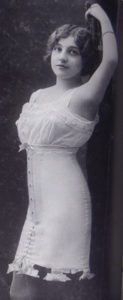
photograph, ca. 1913
Corsets continue to get longer below the waist and shorter above. Their function is less about cinching in the waist and supporting the bust and more about smoothing out the silhouette of the abdomen and hip region. They function more like the girdle of our grandparents’ generation and the body shaper today. However, at this point, they continue to be boned and otherwise constructed using traditional corset techniques.
With the corset, women commonly continue to wear either a chemiseand knickers OR a combination/cami-knickers. The desired silhouette is boxier, feminine curves are suppressed rather than enhanced. The natural waist is maintained. The bust bodice/brassiere was an option for both bust support and flattening of the bustline. As of 1916 “brassiere” is the accepted term for this garment.
Petticoats follow the A-line silhouette that characterizes WWI fashion.
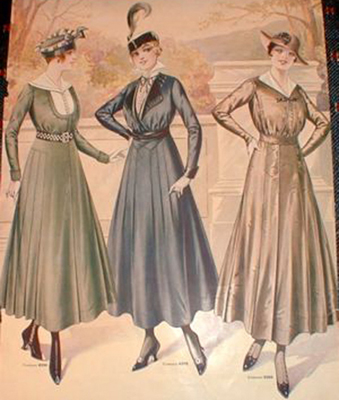
The caption on this fashion plate reads “Fashion Favors the one-piece frock”. 1915
The WWI sihouette continues towards more utilitarian lines. Women favor sensible, serious clothes. We continue to witness a fading of the most feminine details and a conservative approach to decorative techniques. One way that this is achieved is through the addition of menswear details–including pocket shapes, lapels, and preferred fabrics. The decorative interest is in the cut rather than in the added decoration.
The one-piece dress is preferred over the tunic/skirt combination favored during the middle Edwardian years. The coat dress is a popular option for this style.
The overall silhouette favors a natural waistline. The skirt becomes fuller at the hem while still remaining farily smooth smooth at the waist. Skirts shorten revealing the shoes and the ankles quite prominently.
This is the most “natural” female silhouette that we have seen in some time.
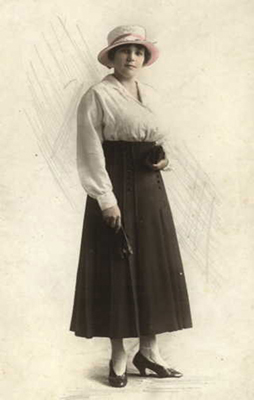
Photograph, ca. 1917-1918
Skirt and blouse combinations are still a common alternative for daywear. These may be paired with a coordinating jacket or worn alone. Matching skirts and jackets are still often referred to as tailormades or simply suits.
Blouses usually feature lower necklines. The high collars are a thing of the past. V-shaped turned back or square-shaped collars are now the norm. There is a new fad for sailor collars.
Sleeves fit smoothly into the armscye and often finish in a cuff. The bishop sleeve (as seen here) remains a popular sleeve style for blouses–think of it as a feminine version of the tradional male shirt sleeve.
Due to shortened hemlines, shoes begin to take on new importance to the overall ensemble. Especially as we move into the 1920s, much more attention is paid to the design and appearance of the shoe.
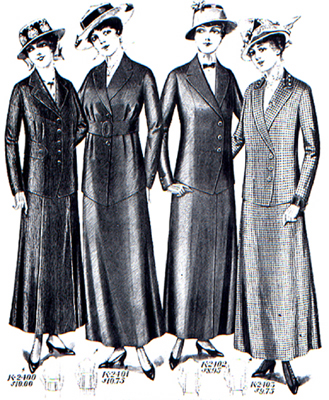
WWI era suits advertised in a mail order catalogue
Suits grow in popularity during the war years. Some take on a pseudo military look–including self belts, and shoulder epaulettes. Jackets tend to be a bit on the longer side–reaching the middle to low hip. Belting is common, though not universal. Placement of the belt is generally at or slightly above the natural waistline.
Knitted sweaters are introduced into ladies fashion after about 1915. Initially a wartime garment issued to soldiers, they quickly find favor in streetwear both for men and women. Both cardigan and pullover varieties were available. They were rather boxy, without a defined waist, and could be belted at the hip.
Coco Chanel gets the credit for being the first designer to interest women in this new trend.
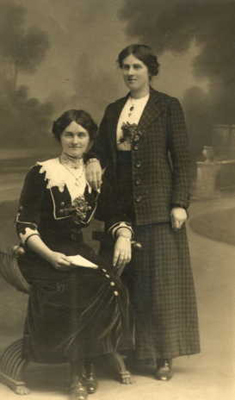
The back of this photo reads, “To Bert with Love from Cissy & Daisy”. circa. 1913-1914

Photo postcard, dated “15-4-13”. The note on the back reads: “Dear Jeanie here are the cards we got taken at Wollongong. You would think we had Both got a fright by the look of us. My Pal got married on Saturday. No more at Present. Love from Kate.”
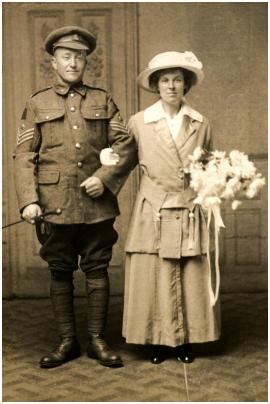
WWI Canadian soldier’s wedding of a Canadian Machine Gun Corps sergeant with his new bride in York, Yorkshire.
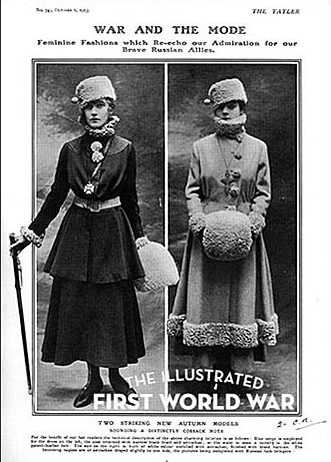
War and the Mode – Russian influenced fashions in The Tatler, 6 October 1915. © Illustrated London News Ltd/Mary Evans
Recent Comments